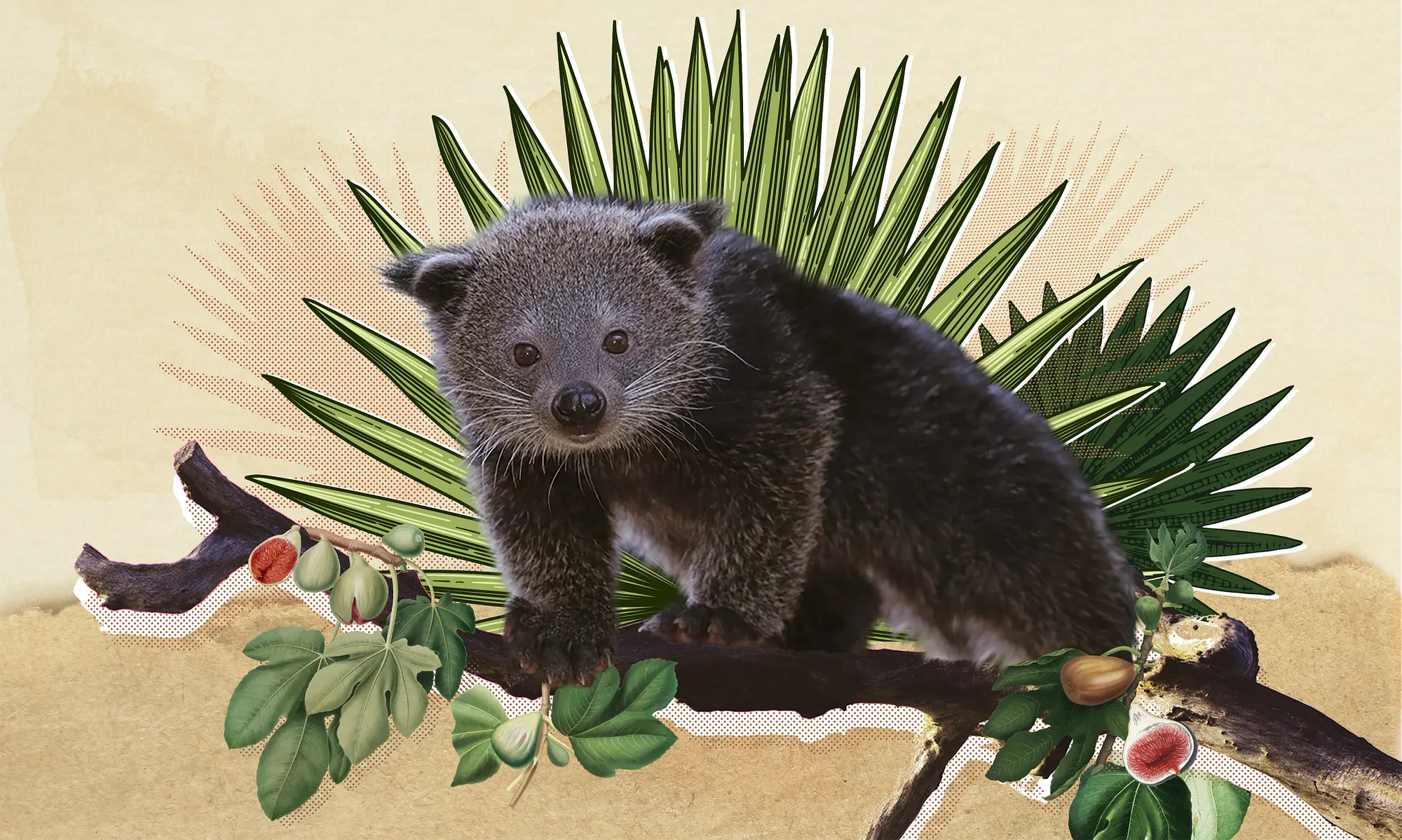While Saigoneer’s Natural Selection series has already covered a number of iconic species and types of animals, including the tiger, Asian elephant, dogs and cats, there’s a good chance most of the people reading this haven’t heard of today’s critter.
Cầy vằn bắc (Chrotogale owstoni), or Owston’s civet, is a member of the civet family, which spans over a dozen species across tropical Africa and Asia, with Southeast Asia accounting for most of this diversity. This particular civet is named after Alan Owston, a British wildlife collector who lived from 1853 to 1915. The cầy is identified by four black-and-white stripes on its back, and they feed on earthworms, sweet fruits, small animals and insects.


Civets are small, omnivorous mammals that are largely nocturnal, and in Southeast Asia they are best-known for their link to civet coffee, which is largely produced in Indonesia as kopi luwak, the Philippines under different regional names, and here in Vietnam as cà phê chồn — sometimes you may see it sold simply as “weasel coffee.”
To create this coffee, an Asian palm civet (Paradoxurus hermaphroditus) is fed coffee cherries, which they partially digest and then poop out. The cherries are fermented during this process, and then turned into coffee. This practice — which raises serious ethical questions in its modern form — began in the 19th century amongst locals who resorted to them after not being able to afford the beans they harvested for the Dutch.
But we’ll return to that later, as the Owston’s civet isn’t actually used for cà phê chồn.

To create cà phê chồn, an Asian palm civet is fed coffee cherries, which they partially digest and then poop out. The cherries are fermented during this process, and then turned into coffee.
According to a report titled “Conservation Strategy for Owston’s Civet 2019-2029” compiled by five major conservation organizations, this species was listed as Endangered on the IUCN Red List of Threatened Species in 2016, and has among the smallest distribution area of any omnivore in Asia. Vietnam accounts for most of its natural range, though Laos and a section of southern China also host Owston’s civets.
Trinh Thi Mai, Owston's Civet Programme Coordinator at Save Vietnam’s Wildlife (SVW), tells Saigoneer in a call that there is discussion of whether the species should be upgraded to Critically Endangered, as experts estimate that their population has declined by 50% over the last 15 years thanks to habitat loss and indiscriminate hunting and poaching.
“In 2020, we set camera traps in four national parks, and we only found Owston’s civets in Pù Mát [in Nghệ An Province], though there is recorded history in Cúc Phương,” she says. “We got seven pictures in Pù Mát, but this is an elusive species that is hard to capture by image.”



An Owston’s civet (Chrotogale owstoni) photographed in captivity at Cúc Phương National Park, a major partner in the international cầy vằn bắc breeding program. Photos by Robert Marc Lehmann.
Mai adds that there have been recent reports of cầy vằn bắc in Kon Plong, a district in Kon Tum Province that is an emerging biodiversity hotspot, which is a positive sign, but more research is needed as a population in the area has not been confirmed yet.
“This means there are still some surviving habitats we don’t know about, and we haven’t estimated their population, but it seems there are some animals there,” she says.
Sadly, the species is a victim of extremely bad luck. Unlike the pangolin, it is not specifically targeted for meat or medicinal practices with zero scientific backing; and unlike the Asian palm civet, it is not targeted for coffee production: but it is caught in the deadly crossfire of these trades.

The coffee threat
“Because civet farming operations depend on wild civets to restock, and because the most common hunting method is snaring, we can assume that this supply chain will impact all ground-dwelling civet species, including species which are not used in civet coffee production,” explained Daniel Wilcox, Chair of the IUCN Small Carnivore Specialist Group, in an email.

Snares are cheap traps that close around an animal’s leg and either hold it in place until it dies from dehydration or starvation, or leave it mortally wounded even after escaping. They are a huge driver of wildlife loss in Southeast Asia.
Did you know?
The WWF estimates that over 12 million snares are in place at any time across forests just in Cambodia, Laos and VietnamAccording to Wilcox, most endangered wildlife species in Vietnam have almost no presence outside of protected areas, so hunters largely focus on these spaces, and there is no precise targeting when it comes to a snare: if one was set in order to supply palm civets to a civet coffee farm, it will still close around the leg of an unwitting Owston’s civet. Civet coffee farms don’t need the Owston’s since they are difficult to raise, but there is still a connection.
“Civet meat is another commodity in the country, so it is easy to imagine hunters illegally snaring inside protected areas and then selling civets that produce civet coffee, with all the other non-coffee eating species being sold for their to meat to restaurants, or possibly to civet farms,” Wilcox says.
“In 2020, we conducted research focusing on coffee farms in order to search for the Owston’s, and we found that among 57 farms in Lam Dong and Dak Lak, none had this species, but people from at least two farms said they had seen them in other provinces,” Mai recalls.
In 2019, SVW rescued three Owston’s civets from a farm in Lâm Đồng. This incidental link between the civet coffee industry and the Owston’s civet is deadly for the latter, but it’s worth taking a moment to highlight the sector’s impact on the civets it does use as well. According to Mai, the conditions at civet coffee farms are generally poor, with the animals kept together in very small enclosures.
“These are solitary animals, except during mating season, so it’s very stressful for them and they can attack each other,” she warns. “They are also fed industrial food, and are force-fed coffee fruit during coffee harvesting season, which can be poisonous when they are fed continually.” A common palm civet may naturally eat some coffee fruit in the wild, but only as a nutritional supplement to its normal diet: “When they are force-fed coffee, it’s not good for their health at all,” Mai adds.
Experts’ message for anyone considering civet coffee, either in Vietnam or elsewhere, is simple: “Don’t buy it!”

Given this, Wilcox’s message for anyone considering civet coffee, either in Vietnam or elsewhere, is simple: “Don’t buy it! We know it impacts wild civets, and the conditions that civets are kept in are horrendous…Even if one can close their eyes to the conservation and animal welfare impacts, then the public health risks that this industry poses are enormous.”
Mai notes this last aspect as well, explaining that a virus at one civet farm in southern Vietnam killed every civet there, and viruses can easily jump to other species — including humans, as we have all been made well-aware of over the last two years.

The future of the Owston’s
Given the complex nature of the threats facing this species, conservationists are pushing for a concerted effort largely within Vietnam to prevent it from extinction.
The most prominent angle of this is the creation of a sustainable breeding program. In fact, an ex-situ program does exist through cooperation between Cúc Phương National Park and several zoos in Europe, including the Newquay Zoo in the United Kingdom, but the involved population is too small.
As the 2019 conservation strategy report notes, reducing demand for wild meat and strengthening protection from hunting would greatly benefit the Owston’s civet, in addition to countless other species, but these are incredibly difficult tasks that will take decades to accomplish.
Mai explains that breeding is a major focal point of SVW moving forward, and they are already working with the Saigon Zoo — which has seven cầy vằn bắc — to eventually move the individuals to Cúc Phương for breeding. “We are planning to work with other zoos across Vietnam so that when they receive an Owston’s, they contact us and work on the breeding program,” she says. “We’re also working with wildlife farms to raise awareness.”



A cầy vằn bắc at the Saigon Zoo. Photos by Michael Tatarski.
This includes a website called NoCivetCoffee.com and a Facebook page called "No Civet coffee - Không sử dụng Cà phê chồn" that “raise awareness of civet coffee consumers on civet conservation problems, as well as civet welfare and zoonotic diseases that might associate with civet (coffee) farms in Vietnam.”
SVW has also come across some evidence of Owston’s civets being sold online as pets, though the extent of this — as with so many aspects of the wildlife trade, both legal and illegal — is unknown.
Breeding is seen as the most viable path forward, with Mai explaining that conservationists want to start now, instead of waiting until the species nears extinction — an outcome that is plausible given ongoing levels of hunting in its range and the fact that we don’t know how many cầy vằn bắc remain in the wild.

While the conservation report features a number of specific goals for the next decade that will require intense work from both the public and private sectors, there are two simple steps to help the Owston’s civet, and other species, that anyone reading this can take: don’t buy cà phê chồn, and tell other people why they shouldn’t consume it either.
Unless you visit the Saigon Zoo, you may never see a cầy vằn bắc in person, but know that the small, uniquely striped-and-spotted animals will thank you for doing so.
Graphics by Hannah Hoàng, Phan Nhi and Simona Nguyễn.
Photos by Matthew Maran, Newquay Zoo, Shaldon Wildlife Trust, Curriculum Nacional, Michael Tatarski, Zoochat.com, iucnredlist.org.

















